Cement
US Cement Plant Using SCR Pollution Control Device Achieves 80% Reduction. Texas Says It’s Still Not Feasible.
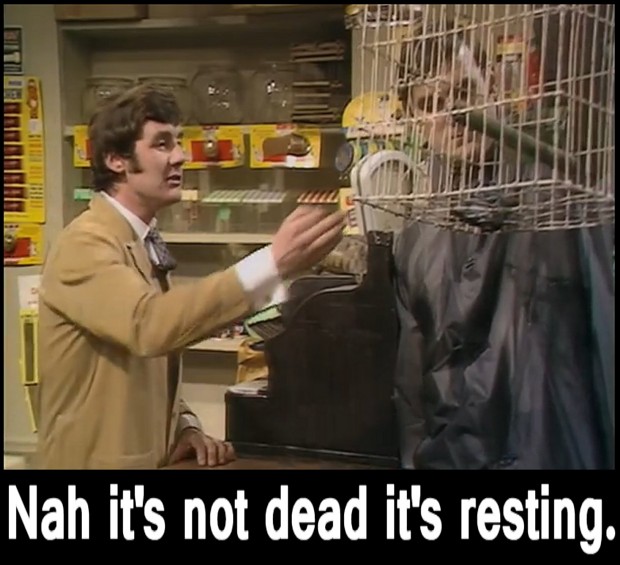 EPA has released the results of the first test of a full-scale Selective Catalytic Reduction (SCR) unit on a US cement plant and the numbers look good.
EPA has released the results of the first test of a full-scale Selective Catalytic Reduction (SCR) unit on a US cement plant and the numbers look good.
As many of you know, SCR is just an industrial-sized version of the catalytic converter in your car. It can capture up to 90% or more of the smog-forming pollution from a cement plant. In use on cement kilns since 2001, there are at least a half a dozen cement plants in Europe that use SCR successfully, but the technology has been slow to arrive in the US because of regulatory laziness and industry resistance.
But after 15 years, that's finally changing.
in 2013, LaFarge Cement entered into a consent decree with the EPA and the US Justice Department as part of a settlement over a string of environmental violations, including excessive smog-forming Nitrogen Oxide (NOX) emissions. As part of that settlement, Lafarge was to retrofit its Joppa, Illinois "dry process" cement kiln with an SCR unit, record its effectiveness during stack testing, and report on the results of those tests by 2015.
This last week, those results were finally made available by EPA and they show SCR was able to reduce NOx by 80%.
That's approximately twice as effective as SNCR technology, (Selective NON-Catalytic Reduction), the current pollution control device for NOx most often used in U.S. cement plants.
Moreover, according to LaFarge, "the SCR control technology performed well and no operational problem was encountered."
In fact, the control technology worked so well, LaFarge is now getting a permit from the Illinois state environmental agency to operate SCR past the EPA-mandated settlement period.
But while LaFarge is getting its SCR permit, Holcim's Midlothian cement plant has already applied and been granted one by the Texas Commission on Environmental Quality for construction and operation of its own SCR unit. It should be up and running by this time next year.
So that makes two U.S. cement plants with permits to run full-scale SCR units. One that was forced into the choice by EPA and now wants to keep using it, and another voluntarily adding it.
But according to the TCEQ, even though it gave a permit to Holcim to install SCR, and even though Holcim's SCR unit will be operational in a year, and even though the LaFarge test was a success, and even though SCR has been used for 15 years by European cement companies – SCR is "not economically or technically feasible." That's exactly what the Commission said in response to comments from both citizens and the EPA in its new clean air plan for DFW a couple of months ago.
That's right. One the one hand the Commission has granted a permit to Holcim to build an SCR unit in its own backyard, and on the other it's still calling the technology infeasible. It's the stuff of Monty Python sketches.
And that's not all. There is no mention of the Holcim Cement SCR permit in the TCEQ's own official arguments against SCR in its DFW clean air plan. Not one. Since Holcim's building of an SCR unit would tend to empirically disprove TCEQ's contention that the technology wasn't practical, the state just pretends it's not happening. As with climate change and smog, any facts that conflict with the pre-determined ideologically-correct premise must be ignored.
Presumably, Holcim is building the SCR unit because it's made the business judgment that the technology is not only both economically and technologically feasible, but beneficial to the company's bottom line. Presumably LaFarge is pursuing a permit for its SCR unit because it has made the same practical decision. Yet, in a strange role reversal, a Texas state government agency is now telling business it's making the wrong choices. It's overruling the industry's decision to reduce pollution through SCR use by saying "not so fast."
This is how bad its gotten: the Texas approach to clean air is now so backwards that the cement industry is more aggressive about reducing pollution than Austin.
So how many U.S. cement plants have to be operating with SCR before the State of Texas concludes it's a feasible technology? Two? Four? A Dozen?
Fortunately, the TCEQ isn't the last word on this. The Clean Air Act says any and all reasonably available technology must be used on major pollution sources like the Midlothian cement plants when a clean air plan is being drafted. TCEQ hasn't done that. We think they're breaking the law. There are signs that EPA thinks so as well.
EPA is ultimately in charge of enforcing the Clean Air Act, and if it doesn't do it correctly, then the courts step in.
The best hope for safe and legal air in DFW is for EPA to rigorously enforce the law. The State of Texas will not do so. If you agree then please take a minute to:
1) sign this petition to EPA
2) Send this e-mail to EPA
Thanks.
The State’s “Do-Nothing” DFW Air Plan is Falling Apart. Here’s Our Chance to Have a Real One.
 For the second time in five years, the Texas Commission on Environmental Quality thought it had gamed the system. It believed it could get away with another DFW "clean air plan" that didn't actually do anything. It looks like it was wrong.
For the second time in five years, the Texas Commission on Environmental Quality thought it had gamed the system. It believed it could get away with another DFW "clean air plan" that didn't actually do anything. It looks like it was wrong.
A series of events playing out since December of last year has seemingly laid waste to the state's intent to get approval from EPA for its "State Implementation Plan" (SIP) for DFW smog that didn't touch the major sources of air pollution in North Texas. As a result, citizens have an opportunity for the first time since 2011 to get a real clean air plan – but only if we organize and focus on demanding EPA do its job.
Stick with us here. It's kind of a long trip, full of regulatory jargon and jousting, but the destination is worth it.
Because of what seems like an intractable disagreement between the state and EPA over the content of the state's proposed 2015 air plan for DFW, citizens have a chance to press for the real thing – a federal plan, drafted and implemented by EPA – that could finally bring deep cuts to major sources of pollution like the Midlothian cement kilns, East Texas Coal Plants, and the oil and gas industry.
If that sounds like an attractive option to you, there are two things you can do right now to make it more likely:
1) Sign the petition for a Federal Plan at Change.org
In the last six months the fate of the state's plan has been radically altered. Among the most dramatic changes:
1) Only days before Christmas, a federal court ruling pushed back the deadline for DFW to meet the current 75 parts per billion ozone/smog standard from 2018 to 2017. Despite knowing about the court decision, until very recently the state kept aiming its plan at 2018. It hadn't made changes to its computer modeling to adjust to a 2017 goal. Now there's a real question as to whether it can submit all the data EPA requires by a July 20th deadline to turn it in for review. If the state doesn't get all the information in, EPA must rule that the plan is "incomplete." As of right now, a month before it's due, that's the conclusion EPA would have to reach.
2) Official EPA comments on the state's plan are highly critical of it, echoing many of the same assessments raised by citizens in the January Arlington City Hall hearing, and written comments submitted by Downwinders and the Sierra Club. For example,
– The inadequacy of the state's plan and need for more pollution reductions: "…it is difficult to see how the area would reach attainment in 2018….The fact that the attainment year will likely be 2017 makes the chance of attainment smaller…The recent court decision…makes it less clear that the area will attain the standard by 2017 without additional reductions…we believe it is likely that additional reductions will need to be included to demonstrate attainment.”
– The quality of the state's computer modeling, which drives the entire plan: "The monitor data does not show the large drops in local ozone levels and therefore raises a fundamental question whether the photochemical modeling is working as an accurate tool for assessing attainment in 2018 for DFW”….the episode overall is not fully representative of the most difficult ozone scenarios. In addition, while current ozone trends and the model predictions support that ozone levels will continue to improve, it is not clear to EPA that these trends are sufficient for the area to attain by 2018.”
– More cuts are needed from the Midlothian cement kilns: "…the TCEQ estimates that reducing the source cap for the kilns in Ellis County would not provide significant emission reductions for the DFW area. However, a reduction in the source cap…does appear significant...TCEQ’s rules need to be reevaluated to insure…the emission limits reflect a Reasonably Available Control Technology (RACT) level of control as required by the Clean Air Act….We can no longer conclude the emission limit that is in place reflects a RACT level of control…Failure to conduct a thorough RACT analysis for cement kilns which would include appropriate emission limits would prevent us from approving the RACT portion of the attainment plan submittal.”
– More cuts are needed from the East Texas coal plants: “The TCEQ provided an evaluation of emissions from all of the utility electric generators in east and central Texas. However, the discussion in Appendix D on the formation, background levels, and transport of ozone strongly supports the implementation of controls on NOx sources located to the east and southeast of the DFW nonattainment area."
What is that discussion in TCEQ's Appendix D? It's this incriminating admission: "…efforts focused solely on controlling local emissions may be insufficient to bring the DFW area into ozone attainment …."
– Link between oil and gas sources and higher ozone levels: "These monitors (Eagle Mtn. Lake, Denton, and Parker County) are in areas more impacted by the growth in NOx sources for Oil and Gas Development that seem to be countering the normal reduction in NOx levels seen at other monitors…."
"We have some concern that as well pressure diminishes that natural gas fired engines driving natural gas compressors may be utilized more than the current usage per production amount. This may result in the projected NOx emissions not dropping as much as projected. The same volume of gas being produced with less well head pressure flow could need more overall actual compression to get to market. This situation could result in more NOx emissions than estimated based on the current emissions/production level relationship."
3) EPA requests for information from TCEQ leave no doubt that EPA wants more pollution cuts in the plan and that without those cuts, the plan is in deep trouble. Examples:
– “Please provide the estimated amount of emission reductions (in tons per day) that would reduce ozone values at the monitors by 1 ppb…please include the estimated emissions reductions associated with each of the (control) measures."
– “An evaluation…for cement kilns in Ellis County is needed that reflects the level of control that can reasonably be achieved and new limits to reflect the reasonable level of control.”
– “How would a reduction in emissions from utility electric generators in just the counties closest to the eastern and southern boundaries of the DFW area impact the DFW area?”
– “The updated modeling results provided in early January by TCEQ indicate one monitor at 76 ppb in 2018 using the new DRAFT guidance and existing guidance methods indicate 77 ppb at Denton and 76 ppb at Eagle Mtn. Lake and Grapevine. We note that these numbers will most likely go up some with an attainment demonstration based on 2017. We request that TCEQ supplement their analysis as needed to show that the area will attain by 2017.”
All of those EPA comments and requests were made way back in early February. The state only got around to responding to them on June 3rd. With the July 20th deadline for final submission of a DFW air plan to EPA rapidly approaching, this is TCEQ's June 3rd answer:
"It was not possible to complete all work necessary for this DFW Attainment Demonstration SIP revision to demonstrate attainment in 2017. The DFW AD SIP revision also commits to develop a new Attainment Demonstration SIP revision for the DFW 2008 eight-hour ozone non-attainment area as long as 2017 remains the attainment year. The new DFW Attainment Demonstration SIP revision would include the following analyses to reflect the 2017 attainment year: a modeled Attainment Demonstration, a reasonably available control measures (RACM) analysis….."
Rhetorically, TCEQ seems to be committing to submitting a new plan or parts of a new plan to EPA by July 20th, but it's very unclear how much, if any a "new" TCEQ DFW air plan will differ from the current one. The modeling for 2018 took Austin over a year to finish and there are serious doubts about whether the state can condense that process into less than two months to churn out entirely new results for 2017.
Moreover, the state knows what it will find if it does accomplish that feat: higher ozone levels.
At its most basic, the TCEQ plan for 2018 attainment with the 75 parts per billion standard relied exclusively on federal changes in the chemical make-up of gasoline that will reduce its sulfur content, due to hit the marketplace in January 2017. Before the December court ruling, that meant a whole two summers for that fuel change to reduce the pollution from cars without the state lifting a finger to cut pollution from industrial sources like the cement kilns, coal plants, or gas industry.
Now, however, with the attainment date moved up by a year, it means only one year of impact from that fuel change. It means that instead of averaging the 4th highest ozone readings from 2016, 2017, and 2018 for the required rolling three- year average that determines success or failure, it will be this year, 2016 and 2017. Two out those three years will not see the benefit of that federal fuel change on the marketplace, resulting in a higher number than the state was counting on before. Will the state want to put that new number on paper? Because when/if it does, it's Exhibit A for the need for new pollution cuts the state will have to impose. And it really doesn't want to do that.
TCEQ could ignore the July 20th deadline while it works on updating its modeling for the 2017 deadline. Officially, EPA has up to six months (until January 20th, 2016) to decide the state's plan is "incomplete." It could be that EPA accepts a tardy TCEQ 2017 computer model while the state scrambles to come up with its next ridiculous theory to propose in lieu of real cuts from major polluters.
But just pushing back the computer modeling to 2017 wouldn't solve all of the state's problems. For one thing, the gap between projected ozone levels and the goal of 75 ppb will be wider because we're looking at 2017, not 2018. They'll be more ozone that needs reducing. How do you do that? EPA could also find a new state approach inadequate in the same ways it's shooting down the current "do-nothing plan" if it doesn't analyze the impacts of cuts from major polluters. EPA seems to be boxing-in the TCEQ to either admit the need for more real reductions from major sources, or face being "incomplete."
Secondly, and based on TCEQ's June 3rd response to EPA, seemingly even more awkward, is the EPA's request for the state to perform a new review of control measures and their impacts on DFW smog levels. You can't get any more explicit in EPAese than "Failure to conduct a thorough Reasonably Available Control Technology analysis for cement kilns which would include appropriate emission limits would prevent us from approving the RACT portion of the attainment plan submittal.”
As some of us have been saying from the start, TCEQ ignored the fact that there are off-the-shelf controls to get 90% smog pollution reductions from cement kilns and coal plants, controls being used or implemented on kilns and coal plants right now, as well as a long history of electrification of gas compressors in areas of the US with air quality problems.
In its comments and information requests EPA is very specifically requesting drastic, fundamental revisions in the state's analysis, not just in regard to the cement kilns, but also the East Texas coal plants and any other control measure that can get you a 1 part per billion or better improvement in DFW smog levels.
This is something the state is loathe to do. It hasn't done this kind of "sensitivity" analysis in almost a decade. In it's June 3rd comments, it's very clear that the TCEQ is still not finding any reason to revise its opinion that no new control measures on any major sources are needed, and so no such analysis is warranted. "The TCEQ disagrees that the existing cement kiln rules no longer satisfy RACT….and …"the TCEQ has determined that imposing additional controls on these attainment county EGUs (coal plants) is not justified.”
So even though the state says it will work on submitting a new plan aimed at 2017, it's digging in its heels and also saying it's not going to revisit these potential control measures as ways to reach attainment as EPA is requesting. As a result, it's unlikely the state will provide answers to the EPA's many questions about what impacts different controls have on future DFW smog levels.
(If only there was some way to provide those answers to EPA using the TCEQ's own modeling. If only someone had made a copy of the TCEQ model and then run all those "what if" scenarios that the state won't perform.)
On one side is EPA saying the state needs to dramatically revamp its air plan for DFW. On the other is TCEQ saying that it won't do everything the EPA is asking.
What happens if the state won't give in? TCEQ outlines the possibilities in its June 3rd response:
“TCEQ: What are the consequences if this SIP revision does not go forward? Are there alternatives to this SIP revision? The commission could choose to not comply with requirements to develop and submit this DFW Attainment Demonstration SIP revision to the EPA. If the DFW SIP revision is not submitted by July 20, 2015, the EPA could impose sanctions on the state and promulgate a federal implementation plan (FIP). Sanctions could include transportation funding restrictions, grant withholdings, and 200% emissions offsets requirements for new construction and major modifications of stationary sources in the DFW non-attainment area. The EPA could impose such sanctions and implement a FIP until the state submitted and the EPA approved a replacement DFW 2008 eight-hour ozone AD SIP revision for the area.”
And that folks, is what citizens need – a serious FEDERAL Implementation Plan that puts the responsibility for getting cleaner air in the hands of the adults for a change. That's what we all should be asking the EPA to implement.
Waiting for the state of Texas to draft and implement a sincere clean air plan for DFW is the political equivalent of waiting for Godot. Remember the last time the state drafted a DFW air plan in 2011, also exempting major polluters from cuts, it actually raised ozone levels in DFW. After five attempts over 20 years, the state has never met a federal smog clean-up deadline.
Whether you're concerned about pollution from the cement plants, the coal plants, or gas compressors, or just don't want to see the air you're breathing anymore, this is a strategy that can get you real reductions and cleaner air. This is a campaign that can unite a lot of different local groups and causes under one banner.
It's a two step process. First we have to convince the EPA to find the state's plan "incomplete." As you can tell from the EPA's own language, that might not be that hard. But this judgment needs to happen as quickly as it can after July 20th in order to move on to the second decision EPA must make – to formally reject the TCEQ plan, that is, "disapprove" it. On paper, EPA has up to a year to make that decision. Our job is to convince them to do it asap so we can really get down to business.
A formal disapproval will result in the EPA beginning to write a Federal Implementation Plan of its own. Once this process begins the EPA has more of an upper hand. Even if the state panics and submits a new plan of its own, it will have to follow the outlines of what EPA is already proposing. The state has two choices – do it under their own name, or let the EPA carry it out.
Having suffered almost a decade under unprecedented state neglect, DFW air quality is the best example in the US of the need of a federal takeover.
What Texas is doing to subvert the letter and spirit of the Clean Air Act is no different than what southern states did to subvert civil rights legislation in the 1960's. The response from the federal government should be the same now as it was then. If the state won't enforce the law of the land, citizens need the feds to do it for them.
There are two things you can do right now to help this effort, both from the comfort of your own computer screen:
1) Sign the petition for a Federal Plan at Change.org
We need lots of people to begin doing this. Not dozens. Not hundreds. But thousands.
Think about everyone who uses an inhaler in DFW, who knows a family member or friend who suffers respiratory problems. Send this appeal out far and wide.
This is our chance to finally get some progress. We need your help. Thanks.
Ready to Fight Back and Win? Downwinders is about to launch its most ambitious campaign in years
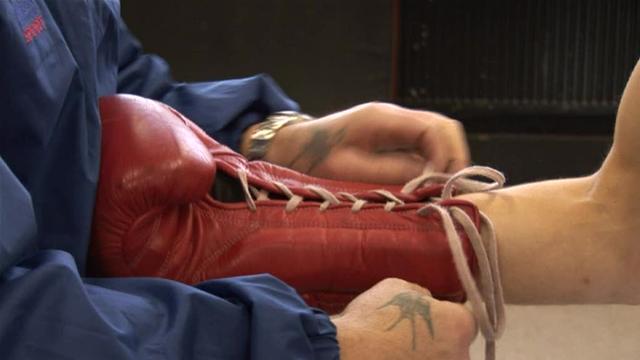
Mercifully, the 2015 Texas Legislative Session is almost over. Since January we've seen cities stripped of their traditional zoning power over oil and gas facilities, citizens' ability to challenge new pollution permits further suppressed, and renewable energy sources singled-out for financial punishment.
But the circus leaves town on June 1, and shortly after that Downwinders at Risk will be gearing up for the largest clean air campaign we've taken on since our fight against hazardous waste burning in the Midlothian cement kilns.
It'll begin with the mid-summer release of the results of a years-in-the-making project that turns the tables on the recent trend to transfer all pollution decisions from local governments to Austin. For the first time, city and county officials in North Texas will have the power to do what, up until now, only state agencies could do.
We don't want to give away too much too soon, but this is by far the single most costly project we've ever sought funding for, and it will have an impact on every major industrial source of pollution affecting Dallas-Fort Worth air quality – the cement kilns, the oil and gas industry and the obsolete East and Central Texas coal plants. And It's being done in a way that makes its results unimpeachable by a hostile state government and industry.
As a kind of sneak peak, below is a small sample of what we're talking about. It's a map of our half of Texas with the DFW metropolitan area outlined in black near the top. It shows the reach and intensity of smog pollution from the five coal plants closest to us. Even though they're 90 to over 100 miles away, they're still able to raise smog levels in central DFW by 4 to 8 parts per billion or more – a huge amount that could make or break our compliance with the Clean Air Act.
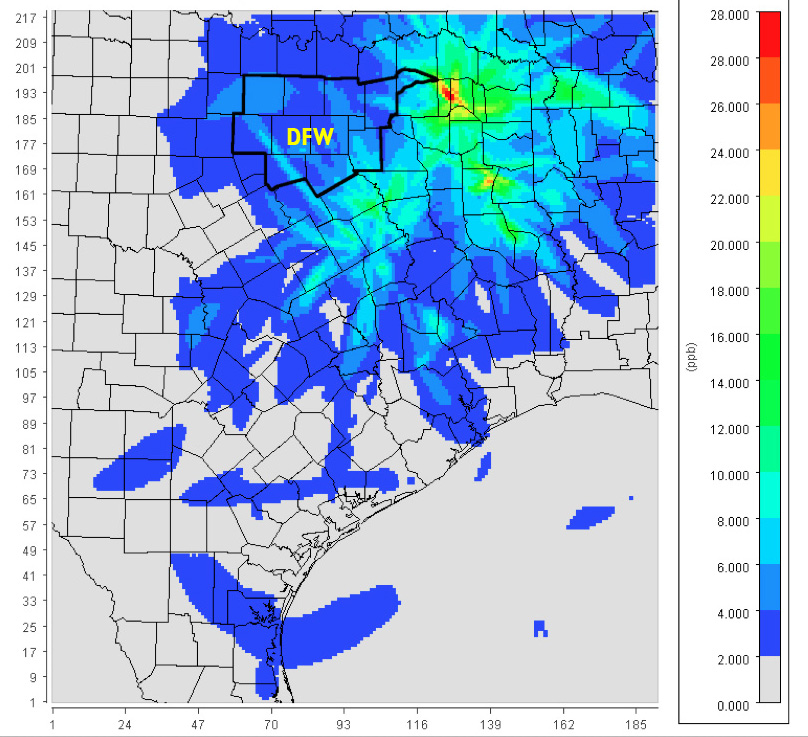 This is a map the Texas Commission on Environmental Quality has the ability to produce, but refuses to. Now, we have the same ability. And we can aim it at any large industrial source of pollution in the region. And we have.
This is a map the Texas Commission on Environmental Quality has the ability to produce, but refuses to. Now, we have the same ability. And we can aim it at any large industrial source of pollution in the region. And we have.
Moreover, the results of our study are being released in tandem with an associated project by Dr. Robert Haley and the University of Texas – Southwestern Medial Center. Together, they'll represent the opening salvos to a sustained, multi-organizational campaign to address DFW's chronic bad air problems.
Armed with this new evidence and having identified some chinks in the armor of the Status Quo, we see a chance to strike a powerful blow for cleaner air and citizen power. We see a chance to win a significant victory. We don't know about you, but after the last five months, we could sure use some victories.
That's not to say winning will come easy. It's still Texas. But we hope you'll agree that one of they keys to our long track record of success is picking the battles and the battlefields that give us better odds.
Every dollar you give goes to fight
for cleaner air right here in N. Texas
Spanish Study: Link Between Cement Kilns and Cancer
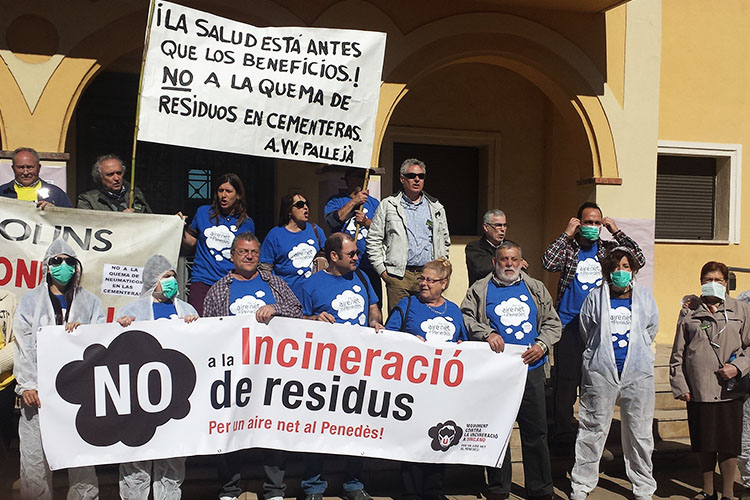 Although it was first published last July, news of a new Spanish epidemiological study of residents living in proximity to cement plants has just now reached us.
Although it was first published last July, news of a new Spanish epidemiological study of residents living in proximity to cement plants has just now reached us.
Done by the the same researchers responsible for a 2012 study that found statistically significant increases in all cancers around waste incineration and auto scrap metal operation, this more recent report focuses just on cement, lime and plaster plants.
According to the researchers, a statistically signifiant increase in all cancer mortality was detected in the vicinity of these installations as a whole, but principally, in the vicinity of cement installations. Specifically, tumors of the colon–rectum in both sexes and of the pleura peritoneum, gallbladder, bladder and stomach in men were noticably higher. In a summary of the results, the authors state they believe residents have "an excess risk of dying from cancer, especially in colon–rectum, in towns near these industries."
Because they take such a long time and so much effort, there's a dearth of epidemiological studies focused entirely on cancer risks among those living in proximity to cement plants, although a 2004 Italian study found a significantly greater risk of lung cancer among people living near a cement factory (whereas the results of another Italian study confirmed significant excesses for cancers like the nervous system, leukemia, mesothelioma and peritoneum in a region with the presence of various industries including cement factories.
In explaining the higher incidence of gut cancers among both men and women, the study hypothesizes about the possible ways local residents are exposed to carcinogens:
In our study, one aspect to be borne in mind is that colorectal
cancer is the only tumor with statistically significant excess risks
in men and women, which might be indicative of a pathway of
environmental exposure. In this case, two possible routes of exposure
to the pollution released by these installations are considered:
direct exposure to pollutants released to air; and indirect exposure,
both to pollutants and liquid effluents which are released to water
and can then pass into the soil and aquifers, and pollutants which
are released to air and then settle on plants. In such cases, the toxins
may pass into the trophic chain, affecting the population.Some authors have already shown associations between colorectal cancer and proximity to industrial pollution sources as metal industries (Garcia-Perez et al., 2010), mining (Fernandez-Navarro et al.,2012), food and beverage sector (Lopez-Abente et al., 2012) andchemical plants (Wilkinson et al., 1997). As regards cement plants,
a Brazilian study found a significant elevation on colorectal cancer
mortality in an industrialized area with cement industries came
into operation in the 1960s, among other facilities (Medrado-
Faria et al., 2001), and a Korean occupational study suggested a
potential association between exposure in the cement industry
and an increased risk of rectal cancer (Koh et al., 2013).
One thing a lot of these overseas studies and the Midlothian area have in common is a concentration of heavy industry. There's usually more than one facility and the region is considered an industrial corridor. That's certainly true of Midlothian, where besides hosting three large cement plants, the town is also home to a huge secondary steel mill, a power plant, and now an LNG plant. These industries combine to present a multitude of possible synergestic combinations of toxins to anyone living adjacent to, or downwind of them. "Toxic soup" is a term often used to describe the result.
This is also why the law lags behind the science in setting standards for cause and effect. When it's the cascade of chemicals from various facilities assaulting you, you're rarely going to be able to link a particular disease or illness with a specific plant. And yet the harm is happening all the same. This is why institutionalizing the "Precautionary Principle" into public policy is so important. It's much easier to prevent a chemical exposure than to track all of its ill effects after it's already doing damage.
Another Reason to Hate K-Cups: They Could End Up in Your Lungs
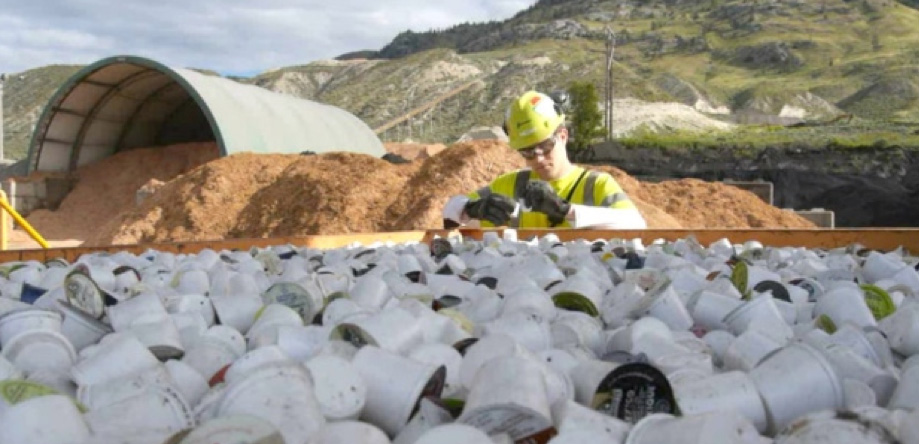 A new frontier in "alternative fuels" for cement kilns has opened up. A LaFarge cement plant in British Columbia has begun burning used plastic single-serving Keurig coffee cups, otherwise known as "K-Cups."
A new frontier in "alternative fuels" for cement kilns has opened up. A LaFarge cement plant in British Columbia has begun burning used plastic single-serving Keurig coffee cups, otherwise known as "K-Cups."
The cups aren't recyclable because they're a mixture of coffee grounds, paper filter, plastic cup and foil top that can't be efficiently separated.
The plant's manager says that the cups are "becoming more and more of a component of our waste steam." A chain delivers the spent cups in large bins. in 2014, over 80,000 pounds, or 1. 4 million, of them were burned at the plant.
Of course, LaFarge claims that the cups are "completely combusted." No mention of the increase in Dioxins/Furans, Polyaromatic Hydrocarbons, or other carcinogens created when the plastic is burned and complete combustion isn't do complete.
K-cups are just the latest piece of "unrecyclable plastic" to be added to the waste stream pouring into cement plants all over the planet. Although the use of hazardous waste as fuel has declined since the 1990's, the use of "industrial wastes" has soared as plants try to find free or subsidized sources of fuel to take the place of coal. Fuel costs are as much as a third of the operational expense of running a cement plant.
Although this new trend hasn't been embraced by Midlothian's three cement plants yet (as far as we know), the permits for TXI and Holcim allow the burning of plastics (along with a host of other industrial wastes), so it's conceivable a K-Cup bonfire could be coming to a kiln near you soon.
A report in February by the group As You Sow, specifically identified the food industry as a large generator of unrecyclable plastics. And one of the biggest culprits it spotlighted was the K-Cup, of which 9.8 billion were produced in 2014 alone. That's enough to circle the globe ten times with the small plastic shells. The Cup's waste is so ubiquitous that it's creator is now said to regret he ever invented it.
One media outfit began using the Cups but then "very quickly realized that this packaging was a problem." So Egg Studios produced a short "Cloverfield" parody where the plastic cups become the weapons of choice for an alien invasion. It's called "Kill the K-Cup.
Downwinders and Sierra Club File Joint Comments on the State’s DFW “Do Nothing”Air Plan
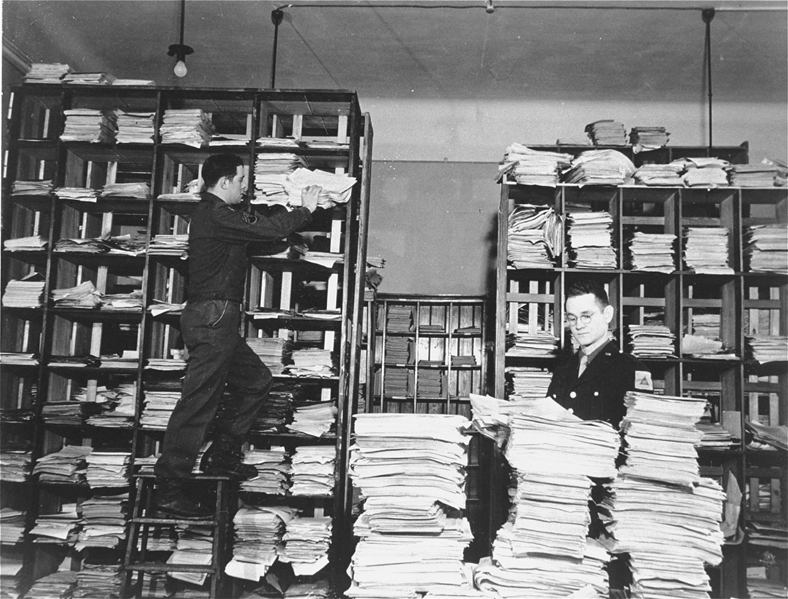 Wednesday of last week saw the deadline for filing official comments on the dreadful "plan" the Texas Commission on Environmental Quality has proposed to lower smog levels in DFW by 2018. In effect, the plan is to wait for federal gasoline changes in 2017 and hope for the best.
Wednesday of last week saw the deadline for filing official comments on the dreadful "plan" the Texas Commission on Environmental Quality has proposed to lower smog levels in DFW by 2018. In effect, the plan is to wait for federal gasoline changes in 2017 and hope for the best.
Shortly before closing time Wednesday, Downwinders at Risk and the Lone Star Chapter of the Sierra Club submitted 62 pages of criticisms concerning the plan. Not because either organization believes the TCEQ Commissioners will change heir minds, but because we're trying to establish a record that might eventually lead to a court challenge of the plan.
Although lengthy, the basic approach of the groups is two fold – call into question the state's computer modeling that's predicting success and challenge the state's exclusion of new pollution control measures on the Midlothian cement plants, East Texas Coal plants and Barnett Shale gas compressors.
Some of the highlights:
– The computer modeling the TCEQ is using for its new plan is the same it used for plans in 2006 and 2011, neither one of them successful at meeting its goal of cleaner air by the assigned deadline. In fact, the last clean air plan using this same model underestimated smog levels by almost 10 parts ber billion and actually saw a slight rise in smog at its conclusion – the first time a DFW plan ever resulted in higher ozone levels.
– In defiance of EPA guidance, the computer model TCEQ is using is more than five years old. EPA specifically recommends using an "ozone season" from 2009 to 2013. TCEQ's model is leftover from 2006, or three years older than the oldest year EPA says is appropriate.
– Also contrary to EPA rules, the TCEQ 2006 computer model ignores including the most relevant “meteorological conditions conducive to elevated air quality.” 2011 was the worst year for ozone levels in DFW since the beginning of this decade, in large part because it reflected the worst drought conditions. The three-year rolling average for the worst monitor, called the "design value" rose back up to 90 parts per billion after years of floating in the mid to upper 80's. But instead of using that year as a worst case baseline, the state defaulted to its 2006 model that doesn't incorporate the current drought.
– TCEQ's prediction of success is built on a series of unrealistic assumptions about the quantity of oil and gas pollution. For example, it underestimates the number and impact of air pollution from hundreds of large compressor stations and thousands of smaller "lift" compressors as the Barnett Shale ages. Fully 60 to 70% of all air pollution from the gas industry comes from these kinds fo facilities, so a mistake in estimating their impact could have a large chain reaction at downwind air quality monitoring sites in Tarrant, Denton, Parker and Johnson counties.
TCEQ also assumes that production levels in the Barnett will fall steeply. If they do not, there could be hundreds of tons more air pollution from the industry annually than what TCEQ assumes in its model.
That's important because the model predicts that the region will only barely squeak-by the 75 ppb standard required by 2018, with levels coming in at 75.87 at the Denton monitor site, 75.15 at Eagle Mountain Lake, and 75.04 in Grapevine. A jump in oil and gas pollution – or any other surge in pollution from any other source – could make those numbers obsolete and ruin our chances fo complying with the Clean Air Act on time…again.
– TCEQ's "Contingency Measures" are illegal. Every smog plan must have a series of quantifiable back-up contingency pans in case the options the plan relies on fail to achieve success. In this case, the state is only relying on unquantified and voluntary actions, such as "incentive" programs, the effectiveness of which cannot be measured. Since you can't measure them, you can't count them.
– TCEQ failed to consider all "reasonably available control technologies" and "measures." Nearly 40 pages is devoted to the wrong-headed, irrational, and illegal way TCEQ rejects off-the-shelf air pollution controls for the Midlothian cement plants, East Texas coal plants, and large gas compressors.
Under the Clean Air Act, a state's plan “shall provide for the implementation of all reasonably available control measures as expeditiously as practicable (including such reductions in emissions from existing sources in the area as may be obtained through the adoption, at a minimum, of reasonably available control technology) and shall provide for attainment of the national primary ambient air quality standards.” In order for the EPA to determine whether an area has provided for implementation as "expeditiously as practicable,” the State "must explain why the selected implementation schedule is the earliest schedule based on the specific circumstances of that area. Such claims cannot be general claims that more time is needed but rather should be specifically grounded in evidence of economic or technologic infeasibility.”
Step-by-step, Downwinders and the Sierra Club explains why Selective Catalytic Reduction (SCR) is a reasonable control technology for the Midlothian cement plants and East Texas coal plants. Even as the owners of one of the Midlothian cement plants applies for a permit to install the technology, TCEQ is claiming its still not ready for prime time. The groups demonstrate how requiring SCR on these major polluters would have a large impact on DFW ozone levels.
The same level of absurdity if reveled in TCEQ's rejection of electrification of gas compressors. Despite being able to significantly lower smog-pollution in the very areas where its needed most, and despite electrification even being required by many Barnett shale municipalities, the state maintains that this option is unrealistic and unachievable.
There's probably no better compendium of the various sins committed by the TCEQ plan than these comments. If you're looking for the most solid case for compressor electrification, or SCR adaptation, or just TCEQ malfeasance, this is your one-stop shop.
You may think this is a technical document, or one full of legal mumbo-jumbo. It's not, at least not for the most part. Instead it's the kind of logical, evidenced case you'd assemble for a debate with the TCEQ. It's a blow-by-blow comprehensive look at why the state isn't any more likely to meet this clean air deadline than it has any other. A case we hope is capable of persuading EPA to reject the TCEQ plan.
Why DFW Residents Should Speak in Favor of a Lower Smog Standard at Thursday’s EPA Public Hearing in Arlington
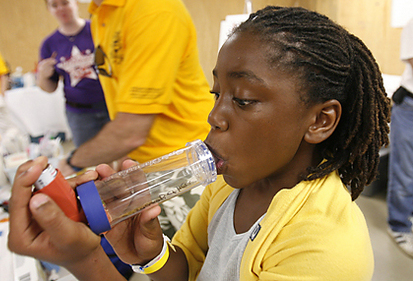
All Day NATIONAL Public Hearing on a New Federal Ozone Standard
Thursday, January 29th, 9am to 7:30 pm
Arlington City Hall, 101 W. Abram
There are only three national public hearings on the possibility of lowering the national federal ozone, or smog, standard. One is in Washington DC, another is in Sacramento, California and the third is right here in Arlington, Texas. We need everyone that can come and speak for 5 minutes on the importance of cleaner air to do so. You know industry and elected officials hostile to the EPA and the Clean AIr Act will be well-represented
To secure your 5-minute speaking slot, e-mail Eloise Shepard and ask for one in the time period during the day on Thursday most convenient for you. Please do it asap: shepherd.eloise@epa.gov.
There are at least two very good reasons why North Texas residents should support a new lower smog standard of 60 parts per billion – the lowest standard under consideration by the EPA.
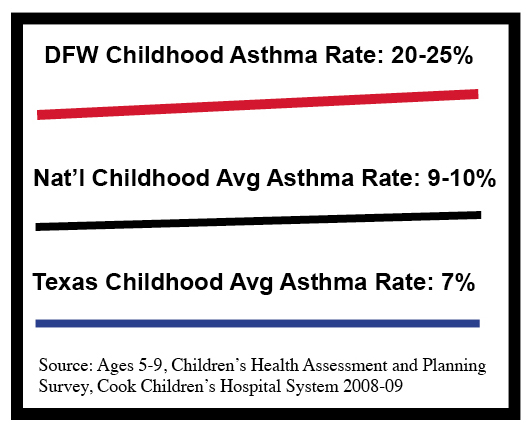 1. DFW has Epidemic Childhood Asthma Rates
1. DFW has Epidemic Childhood Asthma Rates
According to a first-of-its kind survey in 2008 by Cook Children’s Hospital, one out of every four DFW children ages 5-9 suffered from asthma. That was more than twice the national average, and more than three times the average for the state of Texas. Asthma is the most common cause of missed school days and is one of most common causes of Emergency Room visits and hospitalizations.
The DFW Hospital Council estimates nearly 1500 children in Dallas County visited an emergency room or were admitted to a hospital due to asthma in 2012. Dallas County has the highest number of child asthma hospitalization in the state.
According to EPA itself, a new 60 parts per billion (ppb) standard for ozone would eliminate roughly 1.8 million asthma attacks, 1.9 million missed school days, and 6,400 premature deaths nationwide – 95% of all ozone-related deaths. Few regions would benefit more from such a lower ozone standard than DFW.
2. It’s One of the Few Ways to Force Reductions in Harmful Air Pollution in Texas 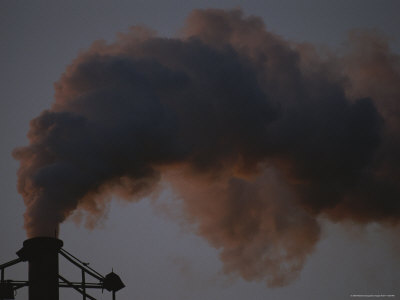
Texas is a place where industry rides rough shod over state regulators and citizens don’t have a level playing field to seek relief from the adverse health consequences of air pollution. Tougher federal ozone standards are one of the only ways to reduce air pollution from large local sources like the cement kilns in Midlothian, gas facilities in the Barnett Shale, and coal plants in East Texas.
Lower federal ozone standards over the last two decades, combined with grassroots campaigns have resulted in the lower volumes of smog pollution from the Midlothian cement kilns, plus reductions in other kinds of harmful pollution from the kilns as well, like particulate matter, and carcinogens. A new 60 ppb ozone standard would mean the kilns would have to add state-of-the-art controls to bring down those totals even more – to as much as 90% reductions. The same is true with the East Texas coal plants and with polluting gas facilities. To get down to 60 ppb ozone levels in DFW could mean deep cuts from the largest sources of industrial air pollution in North Texas. Something that probably won’t happen without a new, lower federal ozone standard.
And that won't happen without a lot of you showing up on Thursday to say you want and need cleaner air to breathe. Reserve your 5-minute speaking slot now. It's a good investment if you live in Texas.
Don’t put away those gas masks yet: EPA’s National Ozone Public Hearing is Next Thursday in Arlington
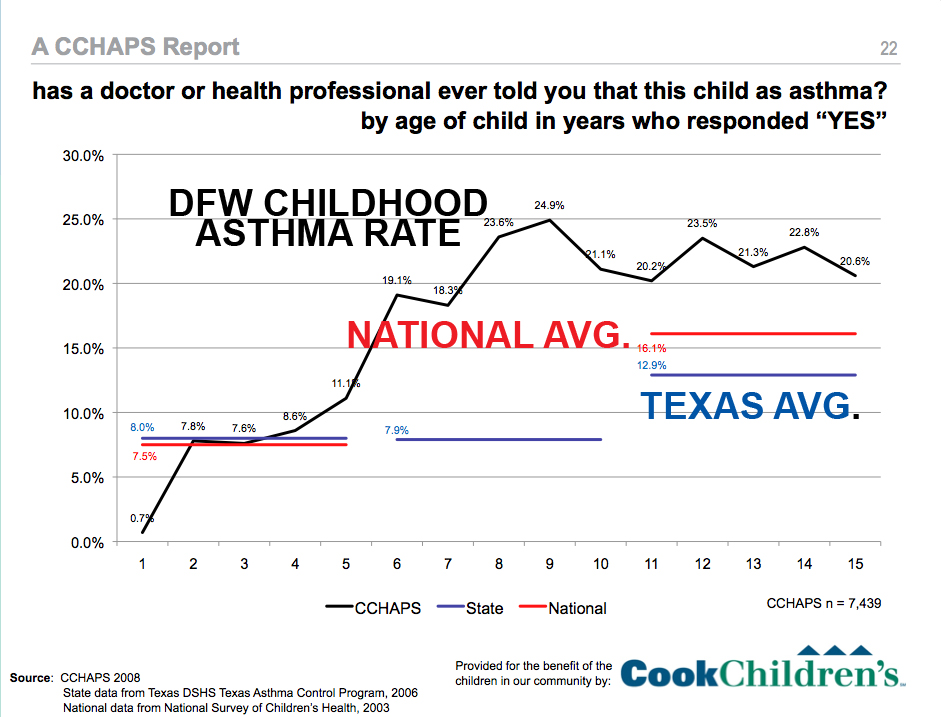
All Day NATIONAL Public Hearing on a New Federal Ozone Standard
Thursday, January 29th, 9am to 7:30 pm
Arlington City Hall, 101 W. Abram
(To secure a 3-minute speaking slot, e-mail Eloise Shepard and ask for one in the time period most convenient for you. Slots are going fast (and not necessarily to citizens), so do it asap: shepherd.eloise@epa.gov)
It's Round Two of January's clean air public hearing marathon, and the biggest has been saved until last.
One of only three national public hearings on lowering the federal ozone, or smog standard, is taking place here in DFW, at Arlington City Hall all day next Thursday January 29th, from 9 am to 7:30 pm.
Last week saw a state-sponsored hearing on another TCEQ do-nothing DFW clean air plan. But the state wouldn't even have to pay lip service to such plans were it not for the requirement to meet a federal ozone level and the region's inability to do so over the last two decades.
Lowering the federal ozone level means it will be tougher in the future for the state to claim it doesn't have to implement any new pollution controls on cement kilns, coal plants, or gas facilities. More importantly, enforcement of a tougher standard means better public health: fewer "bad air days," fewer asthma attacks, fewer trips to the emergency room because your child can't breath, and fewer deaths caused by dirty air.
That's important because reports like the child heath survey from Cook Children's hospital in 2009 showed that childhood asthma rates in DFW were twice the state average and almost 10% higher than the national average. It called the prevalence of asthma among local children an "epidemic."
Currently, the national ozone standard is 75 parts per billion (ppb) – which DFW is still at least three years away from reaching even under the rosiest of scenarios. (Right now our average is 81 ppb, and that's only because of a wetter and cooler summer in 2014). But that 75 ppb number is a political compromise – not one grounded in science. Based on public health studies the EPA's own independent board of specialists has recommended a range of 60 to 70 ppb at least three times since 2008, with an emphasis on the lower end of that range. Now it looks as if the EPA is finally willing to follow through on that recommendation.
EPA's national ozone standard sets the goal of cleaner air that every state must work toward. It drives all new clean air plans. like the one the state of Texas is proposing for DFW right now. The lower the standard, the more pollution has to be reduced. The more pollution has to be reduced, the more controls have to be added to major sources of air pollution to get that reduction. That's how you get long-term clean air progress in states like Texas that refuse to act on their own.
A significant reduction in the federal standard – from 75 (ppb) to as low as 60 ppb would make it much, much harder for Texas to avoid new controls on industry. To give you some idea of how much harder, consider that the state's "plan" for compliance with the current 75 ppb level is completely dependent on a new EPA gasoline mix coming onto the market in 2017. Even then, it's own estimates say that it won't get down below 75 at least three or four monitoring sites. Just one monitor site out of compliance means the whole region is in violation. Short of a huge rise in the use of electric cars, more huge decreases in vehicle pollution aren't expected. Additional significant drops in smog that would be required under a new, lower standard would have to include controls on major industrial sources – like the cement kilns, coal plant and, yes even gas facilities.
When you have a much lower ozone standard, you have to reduce smog by addressing ALL sources of air pollution.
Finding a way to comply with a lower national ozone standard is how more modern pollution controls were mandated almost a decade ago at the Midlothian cement plants. Meeting that new ozone standard meant pollution from the kilns had to be reduced and that made it more possible for Downwinders' "Green Cement" campaign to work with local governments. Today, there are no obsolete "wet kilns" left in Texas – they've all been replaced with more modern dry kiln operations. This has resulted in a reduction of hundreds, even thousands, of tons of smog-forming air pollution from these huge sources every year. We still have to require state-of-the-art Selective Calaytic Reduction (SCR) on the kilns, but they're releasing far less pollution than they were even five years ago because they've had to comply with a new federal ozone level.
With a new, lower ozone standard, the same could be true of new controls on gas facilities, like the 650 large compressors in North Texas, and the East Texas coal plants. That's why it's important for Texas residents to fight for the lowest possible standard this time around. When you testify, please make sure you request a new standard of NOT MORE THAN 60 PARTS PER BILLION.
According to a recent EPA staff analysis, an ozone standard of 60 ppb would reduce asthma deaths in the US by 95%, compared to only a 50% reduction under a 70 ppb level. If you want air that can eliminate all but a small fraction of respiratory problems associated with outdoor pollution, you need to press for a 60 ppb standard.
Needless to say industry is fighting back hard against such a standard, using its usual doom and gloom forecasts of economic hardship. This is the same argument that was used against the current ozone standard – the one we have now in the middle of the biggest economic boom in a decade. In fact, the technology for bringing down pollution levels currently exists in many industries – including kilns, coal plants and compressors. It's not experimental and it's not too expensive to use, as demonstrated by its use right now in those industries. We just have to require its use in states like Texas that are refusing to implement progress. That's why this new standard is so important – it will make the state take action it would not otherwise take. It's one of the only ways citizens who care about cleaner air in Texas can force progress.
Likewise, the Texas Commission on Environmental Quality's own toxicologist, Michael "Smog Ain't Bad For You" Honeycutt will also be testifying. TCEQ knows that a lower standard will force its hand on new controls. It will be pulling out all the stops to use its influence and that of sympathetic elected officials to scuttle any change. Using ideologically-based arguments supported by industry-financed studies, the TCEQ will say there are no real benefits to reducing DFW smog. Those of you that know better have to show up and say so.
Speaking slots for the 29th are going very fast. Industry will be well-represented. Please don't get left out. We need your voice that day to call for a 60 ppb national ozone standard. E-mail the EPA at shepherd.eloise@epa.gov and reserve your time today.
Bottom Line: If You Think DFW Still Has A Smog Problem, Be in Arlington Tonight
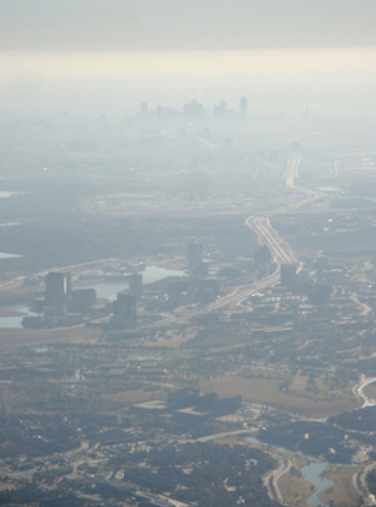 You don't have to have any special technical knowledge. You don't have to know regulatory or legal jargon. You just have to believe we still have a problem with smog in Dallas-Fort Worth. That's all it takes to participate in the air quality extravaganza happening tonight in Arlington. It's a rare two-for one chance to help the fight for cleaner air.
You don't have to have any special technical knowledge. You don't have to know regulatory or legal jargon. You just have to believe we still have a problem with smog in Dallas-Fort Worth. That's all it takes to participate in the air quality extravaganza happening tonight in Arlington. It's a rare two-for one chance to help the fight for cleaner air.
Public Hearing on the State's New DFW Air Plan 6:30 pm Tonight, Arlington City Hall, 101. W Abram
All you have to do is sign-up to speak, wait for your name to be called, and tell the state and the EPA representatives who'll be present that you want something better than a clean air plan that does nothing to get cleaner air except wait for a new federal gasoline formula to hit the market a year before the plan's deadline. The more people that do this, the more pressure EPA is under to reject this terrible state plan. Nothing fancy. Just show up and say you want better – that this region deserves better after two decades of being in violation of the Clean Air Act.
Click here to send prepared written comments to the state and EPA. You can add your own as well.
Roasting and Toasting of Retiring State Representative Lon Burnam – A Fundraiser for Downwinders at Risk, 7:30 -10 pm, Tonight, South Street Patio, 400 South Street – about four blocks east of Arlington City Hall
If you think DFW smog is still a problem, after you say your piece at the state hearing come and support the only group committed to trying making its elimination a priority – Downwinders at Risk. Since the mid-1990's we've been using these air plans to raise issues, get information, and sometimes even win victories that actually do lead to cleaner air. A big reason there's no more burning of hazardous waste in the Midlothian cement plants, and all of those cement plants have upgraded their equipment is because of the work we did around smog. Lately, we've been using them to drive home how much gas and oil pollution contribute to regional smog.
But we need your help – in terms of attendance at public hearings, and in terms of financial assistance. For your donation of $35 to this roasting and toasting of Lon, you get an evening of entertainment and take part in a salute to a real local clean air hero. And you make it more possible to keep challenging the status quo on behalf of your lungs.
CLICK HERE TO GET YOUR TICKETS ONLINE OR GET THEM AT THE DOOR TONIGHT
If you still think we have a smog problem, there's two things you can do about it tonight. Thanks.
Citizens To Form Posse, Demand State Enforce the Clean Air Act at Thursday Hearing on New DFW Air Plan
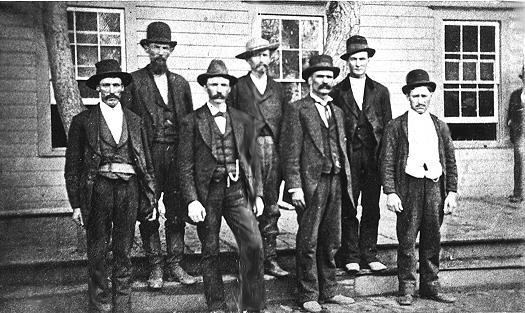 (Arlington) Critics of a new plan to clean the air in Dallas-Ft. Worth are using a public hearing on Thursday evening to accuse the state of Texas of breaking the law by not requiring the implementation of pollution control technologies already in widespread use to help lower smog levels in North Texas.
(Arlington) Critics of a new plan to clean the air in Dallas-Ft. Worth are using a public hearing on Thursday evening to accuse the state of Texas of breaking the law by not requiring the implementation of pollution control technologies already in widespread use to help lower smog levels in North Texas.
“We’re asking residents to come out and get sworn into a citizens posse to help us make the state follow the Clean Air Act,” said Jim Schermbeck, Director of the local clean air group Downwinders at risk, one of the leading opponents of he new plan. “Austin is going to ridiculous, Monty Python-like lengths to avoid new controls on the Midlothian cement plants, East Texas coal plants, and local gas facilities in this new plan – even though those controls are now commonplace in each industry.”
Thursday’s public hearing centers on a new plan to comply with the federal ozone standard of 75 parts per billion (ppb) by 2018. DFW has never achieved such a low level of smog, and only this last year dipped below the 1997 standard of 85 ppb for the first time with the help of cooler, wetter summer.
EPA says a state plan like the one the Texas Commission on Environmental Quality is proposing for DFW must include “all Reasonable Available Control Technologies,” and “all Reasonable Available Control Measures” to get lower smog levels as “expeditiously as possible.” EPA defines these as technologies as ones that are “technically and economically feasible.” But according to Schermbeck, the state of Texas is deliberately ruling out local use of pollution controls already adopted by industry that could speed cleaner air.
He cited three examples. Selective Catalytic Reduction, or SCR acts much like the catalyst on cars, only on a much larger scale for industrial plants. It’s already in use on at least half a dozen European cement plants where it’s reduced smog-forming pollution by up to 90%, and on many coal-fired power plants across the world and in the US, where it achieves the same results. Yet the TCEQ DFW air plan doesn’t require SCR on the largest single sources of smog pollution in the region, the Midlothian cement plants, or the East Texas coal plants that are known to impact DFW air quality, saying the technology isn’t “feasible.” TCEQ maintains this stance even though the Holcim cement plant in Midlothian has announced plans to include an SCR unit on one of its own kilns.
“Here’s a pollution control technology already in operation and achieving great results, with a cement plant in North Texas already adopting it, but the state’s position is that it isn’t ‘feasible’. It’d be comical if it wasn’t delaying cleaner air for over 6 million people that haven’t had it in decades.”
Besides ignoring SCR on cement and coal plants, Schermbeck said the TCEQ has also ruled-out electrification of large gas compressors as “infeasible” – despite the widespread use of electric compressors In the Barnett Shale already and the requirement of municipalities like Dallas and Southlake to allow nothing but electric compressors within their city limits. According to a 2012 study by the Houston Advance Research Consortium, compressors could increase downwind ozone levels as much as 3 to 10 parts per billion. There are at least 647 large compressors in the DFW “non-attainment area” covered by the TCEQ air plan.
“Requiring just these three technologies that are already on the market and being used in their respective industries could reduce air pollution by thousands of tons a year and help us achieve compliance with the new federal ozone standard much quicker,“ said Schermbeck. He said they all pass the test of being feasible according to EPA definitions. “By law, they should be required.”
Instead, the state is relying exclusively on a new federal gasoline mix being introduced in 2017 to achieve the required 75 ppb standard by 2018. Although it’s expected to help lower ozone levels across the country, it won’t get DFW down to the level of 75 ppb alone. To make the plan work on paper, the state has had to estimate oil and gas pollution downward in a way Schermbeck and others claim is unrealistic.
“Basically, the state’s approach is to do absolutely nothing for the next three years and hope the federal gasoline change brings it “close enough” to the lower standard. But hope is not a plan.”
Schermbeck said his group would be passing out badges to members of their clean air posse and recruiting residents to persuade the EPA to reject the state’s proposal. The federal agency has the final say. But there’s also always court – where many clean air rules for the state of Texas have been decided over the last 20 years. “If government won’t enforce the law, we may have to do it ourselves.”
